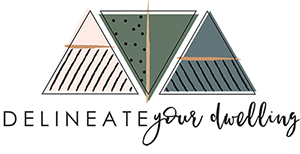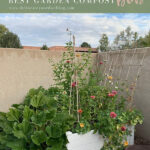Small Garden Compost Bins
INSIDE : Learn how to make your very own nutrient rich vegetable garden soil using small garden compost bins! I love using kitchen scraps to provide better fertilizer in my garden, come check out how simple it really is.
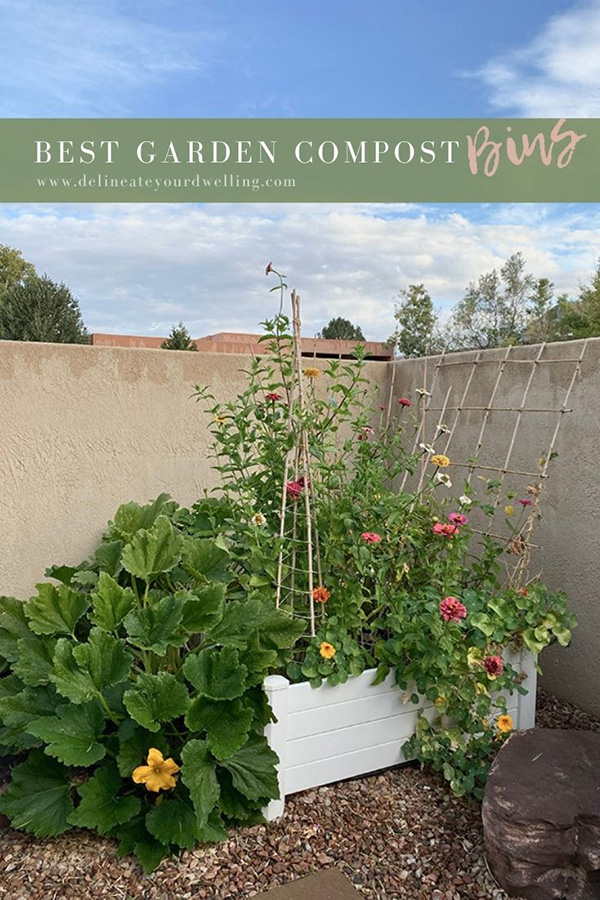
This post may contain affiliate links. See my full disclosure.
This post has been updated since it’s original publish date of April 2022.
HAPPY EARTH DAY!
I have long grown a vegetable garden. The joy seeing those plants go from seed, to fragile little seedling, to plant and eventually watch them fruit into something we can eat… never ever gets old to me. It’s a process that I believe is a privilege to be a part of. (Yes, I’m a landscape architect and self-proclaimed plant nerd.)
If you are starting out on this journey, check out my create a simple raised vegetable garden post. Our yard is not huge and I’ve had a single 4′ x 4′ raised bed for the last two years, which has produced an enormous amount of food. (Last year I mixed in some flowers to the veggie bed.)
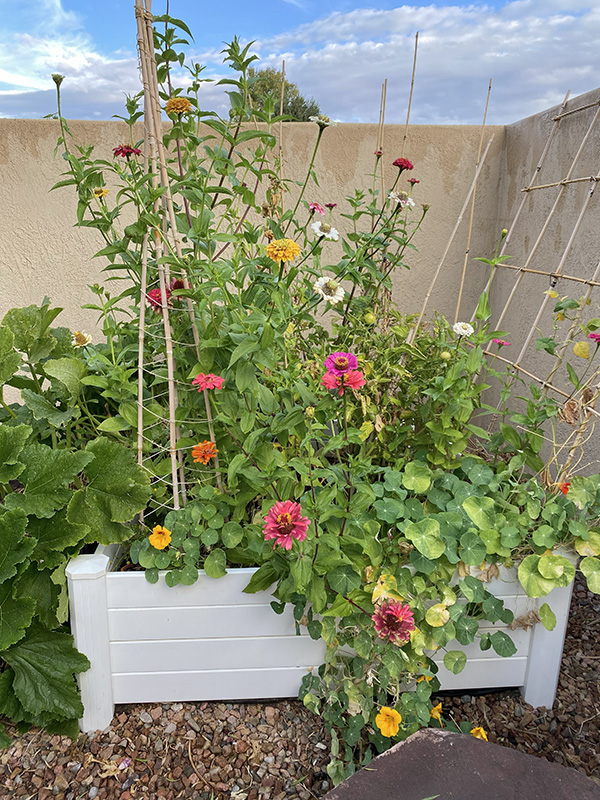
And just this year, I have expanded to 2 raised beds… so watch out veggies here I come!
You might also like Freezing Basil in Ice Cube Trays.
Garden Composting
One thing that has made a huge difference in my garden is that I started composting throughout the year. Not only is it a great way to reduce your kitchen scraps, but it creates wonderfully nutrient rich soil.
If you are new to composting, then there are a few things to know. The most important thing is you have to “feed” the pile with the correct ratios of dry and wet items.
You want to add the below to break down everything into wonderful garden compost.
- 1. organic plant based materials
- 2. moisture
- 3. air
- 4. natural organisms
- 5. time
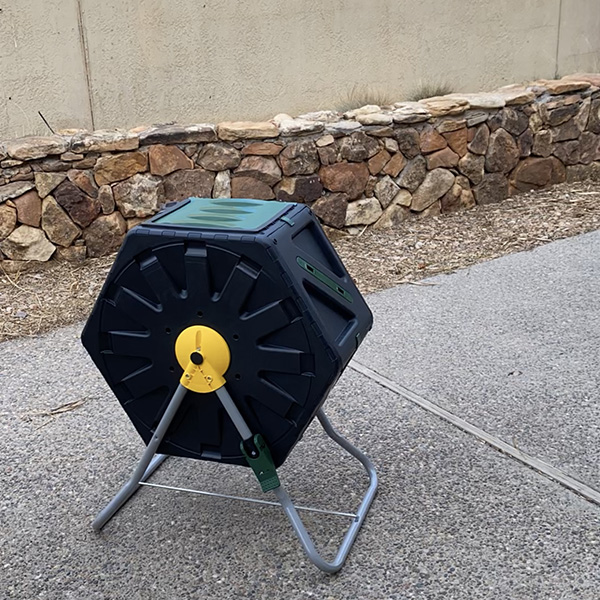
What compost ratios are best?
Typically a ratio of 4 parts browns to 1 part greens works best, but thankfully you do not need to be exact about it.
If you don’t have the proper proportions, your compost pile may not heat up, take forever to break down, and could start to smell.
If your compost pile is not heating up, you may need to add more green material to the compost. If it’s starting to smell, you may need to add more brown material.
What can you compost?
The key for a successful compost bin is the ratio of brown to green materials. Brown materials are the carbon or carbohydrate-rich materials. Green materials are the rich in nitrogen or protein materials.
I compost EVERYTHING you could imagine. Anything that can naturally breakdown, I try to compost. Here is a list of things I suggest.
Brown compost materials-
- Newspaper
- Dryer Lint
- Fingernail clippings
- Hair trimmings
- Dry Leaves
- Dry Grass Clippings
- Small twigs
- Recyclable Packaging
- Pine needles
- Sawdust
- Corn stalks
- Printer paper
- Paper plates, napkins, and coffee filters
- Cotton fabric
- Corrugated cardboard (without waxy/slick coatings)
Green compost materials-
- Coffee grounds
- Tea bags
- Vegetable and/or fruit scraps
- Trimmings from perennial and annual plants
- Eggshells
- Grass clippings
What should you NOT compost?
Really all types of kitchen waste and scraps can be composted, but skip meat, dairy, and fats. These will eventually break down, but they will take much longer and will smell bad. Plus, you can expect non-ideal items to attract flies, rodents, and other unwanted pests.
Indoor Compost Buckets
I love having a small simple indoor compost buckets that I keep under my kitchen sink. I have this white one and it’s pretty enough to sit out, but after a few years it does get a bit grimy inside even if I wash it out.
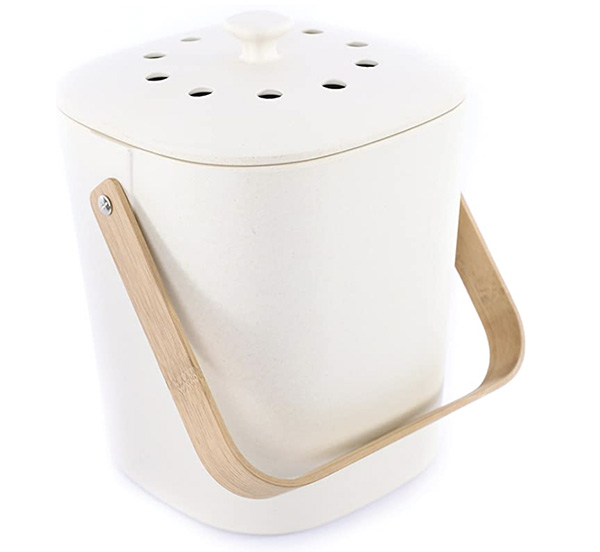
Small buckets like this are ideal for holding a few days worth of kitchen scraps. It is easy while prepping dinner to place all my leftover onion peels and carrot tops into this small bucket and a few days later I can easily carry it out to the small rolling compost bin outside.
Small Rolling Compost Bins
I have tried a few different rolling compost bins over the years and my favorite for our desert backyard is this 18.5 gallon bin. I love it’s compact size and since it’s smaller, it doesn’t take as long to go from veggie scraps to nutrient soil. That’s a win in my book.
Where do you put a compost bin?
You can really compost anywhere in your yard. We originally had our compost bin located in the backyard, so it was easy to access. But, we had a heavy few rains and it felt like we were getting some knats. So I relocated it to our side yard.
The space doesn’t need to be large, just an easy to reach location. And if you notice you are getting bugs or the compost is getting smelly, that’s a sign you should add more brown “dry” materials.
Do dogs mess with compost bins?
If you get a compost bin with a secure lid it should be fairly dog, rodent and critter proof. Many of the ones I’ve owned have plastic sliding doors and are a little tricky for even me to open.
What if my compost pile is smelly?
Typically if your compost pile does not feel warm, it probably is too dry and needs some added moisture. I often lightly spray down the inside contents if that’s the case.
And if the pile is smelly, it is probably too wet and needs to be turned to add air or it may need more dry materials added to correct the wet to dry ratio.
Check out all the compost bins –
